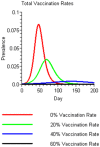Modeling seasonal influenza outbreak in a closed college campus: impact of pre-season vaccination, in-season vaccination and holidays/breaks
- PMID: 20209058
- PMCID: PMC2832017
- DOI: 10.1371/journal.pone.0009548
Modeling seasonal influenza outbreak in a closed college campus: impact of pre-season vaccination, in-season vaccination and holidays/breaks
Abstract
Background: College and university students experience substantial morbidity from influenza and influenza-like illness, and they can benefit substantially from vaccination. Public health authorities encourage vaccination not only before the influenza season but also into and even throughout the influenza season. We conducted the present study to assess the impact of various vaccination strategies including delayed (i.e., in-season) vaccination on influenza outbreaks on a college campus.
Methods/findings: We used a Susceptible --> Infected --> Recovered (SIR) framework for our mathematical models to simulate influenza epidemics in a closed, college campus. We included both students and faculty/staff in the model and derived values for the model parameters from the published literature. The values for key model parameters were varied to assess the impact on the outbreak of various pre-season and delayed vaccination rates; one-way sensitivity analyses were conducted to test the sensitivity of the model outputs to changes in selected parameter values. In the base case, with a pre-season vaccination rate of 20%, no delayed vaccination, and 1 student index case, the total attack rate (total percent infected, TAR) was 45%. With higher pre-season vaccination rates TARs were lower. Even if vaccinations were given 30 days after outbreak onset, TARs were still lower than the TAR of 69% in the absence of vaccination. Varying the proportions of vaccinations given pre-season versus delayed until after the onset of the outbreak gave intermediate TAR values. Base case outputs were sensitive to changes in infectious contact rates and infectious periods and a holiday/break schedule.
Conclusion: Delayed vaccination and holidays/breaks can be important adjunctive measures to complement traditional pre-season influenza vaccination for controlling and preventing influenza in a closed college campus.
Conflict of interest statement
Figures




Similar articles
-
Influenza vaccination among college and university students: impact on influenzalike illness, health care use, and impaired school performance.Arch Pediatr Adolesc Med. 2008 Dec;162(12):1113-8. doi: 10.1001/archpedi.162.12.1113. Arch Pediatr Adolesc Med. 2008. PMID: 19047537
-
Variation in loss of immunity shapes influenza epidemics and the impact of vaccination.BMC Infect Dis. 2017 Sep 19;17(1):632. doi: 10.1186/s12879-017-2716-y. BMC Infect Dis. 2017. PMID: 28927373 Free PMC article.
-
Contact, Travel, and Transmission: The Impact of Winter Holidays on Influenza Dynamics in the United States.J Infect Dis. 2017 Mar 1;215(5):732-739. doi: 10.1093/infdis/jiw642. J Infect Dis. 2017. PMID: 28031259 Free PMC article.
-
The importance of influenza prevention for public health.Hum Vaccin Immunother. 2012 Jan;8(1):89-95. doi: 10.4161/hv.8.1.19066. Epub 2012 Jan 1. Hum Vaccin Immunother. 2012. PMID: 22251992 Review.
-
New vaccine approaches for seasonal and pandemic influenza.Vaccine. 2008 Nov 18;26(49):6232-6. doi: 10.1016/j.vaccine.2008.07.022. Epub 2008 Jul 30. Vaccine. 2008. PMID: 18674583 Review.
Cited by
-
Variation in the timing of Covid-19 communication across universities in the UK.PLoS One. 2021 Feb 16;16(2):e0246391. doi: 10.1371/journal.pone.0246391. eCollection 2021. PLoS One. 2021. PMID: 33592014 Free PMC article.
-
Evaluating a WeChat-Based Intervention to Enhance Influenza Vaccination Knowledge, Attitude, and Behavior Among Chinese University Students Residing in the United Kingdom: Controlled, Quasi-Experimental, Mixed Methods Study.JMIR Form Res. 2024 Oct 24;8:e55706. doi: 10.2196/55706. JMIR Form Res. 2024. PMID: 39447171 Free PMC article.
-
Exploring Influenza Vaccine Uptake and Its Determinants among University Students: A Cross-Sectional Study.Vaccines (Basel). 2020 Jan 28;8(1):52. doi: 10.3390/vaccines8010052. Vaccines (Basel). 2020. PMID: 32013015 Free PMC article.
-
Disease Interventions Can Interfere with One Another through Disease-Behaviour Interactions.PLoS Comput Biol. 2015 Jun 5;11(6):e1004291. doi: 10.1371/journal.pcbi.1004291. eCollection 2015 Jun. PLoS Comput Biol. 2015. PMID: 26047028 Free PMC article.
-
Use of seasonal influenza virus titer and respiratory symptom score to estimate effective human contact rates.J Epidemiol. 2012;22(4):353-63. doi: 10.2188/jea.je20110146. Epub 2012 Apr 21. J Epidemiol. 2012. PMID: 22522150 Free PMC article.
References
-
- Molinari NA, Ortega-Sanchez IR, Messonnier ML, Thompson WW, Wortley PM, et al. The annual impact of seasonal influenza in the US: measuring disease burden and costs. Vaccine. 2007;25:5086–96. - PubMed
-
- Advisory Committee on Immunization Practices. Prevention and control of influenza. Recommendations of the Advisory Committee on Immunization Practices, ACIP 2008. MMWR. 2008;57 (early release):1–60. - PubMed
-
- Mogabgab WJ. Acute respiratory illnesses in university (1962–1966), military, and industrial (1962–1963) populations. Am Rev Respir Dis. 1968;98:359–79. - PubMed
-
- Layde PM, Engelberg AL, Dobbs HI, Curtis AC, Craven RB, et al. Outbreak of influenza A/USSR/77 at Marquette University. J Infect Dis. 1980;142:347–352. - PubMed
-
- Pons VG, Canter J, Dolin R. Influenza A/USSR/77 (H1N1) on a university campus. Am J Epidemiol. 1980;111:23–30. - PubMed
Publication types
MeSH terms
Substances
LinkOut - more resources
Full Text Sources
Medical
Miscellaneous

